GALICIA, SPAIN - Early morning or early evening, the cheerful chatter of birds is constant through the open window in our room at the Santo Estevo de Ribas de Sil, a converted, ancient Spanish monastery. The birds are a subtle reminder of one of the reasons why early Galician hermits and knights came here, almost 1,500 years earlier.
Wanting to be isolated from the temporal world, they chose a life of meditation and contemplation, eventually establishing monasteries in remote and beautiful locations. The amazing thing is that the locations are still excitingly remote. Those finding them are still seeking quiet and solace and, not uncommonly, are real pilgrims, following the Santiago de Compostela Way, or hiking paths that are used merely for the health conscious today.
Walking the road to Santiago (the St. James Way) is a well-known method for pilgrims and hikers who may be merely seeking renewal in their lives, or, as in medieval times, who may be looking to resolve a particular problem or to seek forgiveness for some past wrongdoing.
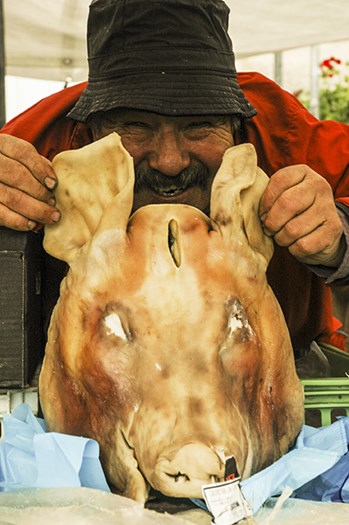
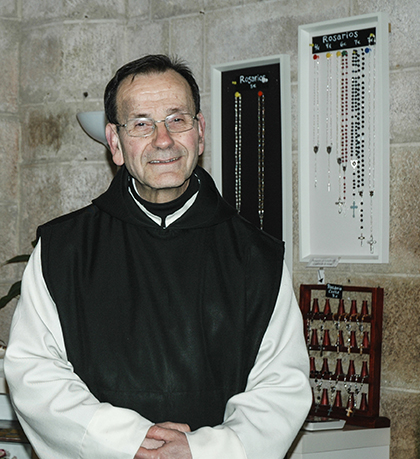
Above: You meet some interesting characters along your Spanish journey.
Today, as Spaniards and foreigners alike make their way through the Spanish countryside, they no doubt become somewhat acquainted with the culture of the Spanish province of Galicia. But how many of them really get to know it?
For starters, they will learn to enjoy the incredibly fresh and fruity Albariño wines that Galicia is famous for and pulpo —octopus served in a variety of ways. I wonder if they’ll learn about the hundreds of legends that haunt this ancient Celtic land. Yes, you read correctly. Galicians are as Celtic as Irish and Scots and are fiercely proud of it.
Most Galicians live near or on the sea and have been building ships and exploring the seas for centuries.
Not surprisingly, seafood is on every menu. We soon learned the local names for lobster, small scallops, large scallops, crab, lobster, shrimps and hake, lots of hake.
Just to underline this strong love of seafood, in interior Galicia, in Ourense, a dish that translates as pigsty seafood, mariscos de cortello, is actually fried pig ears! These delicacies and seafood are enjoyed with the white Albariño wines of Rias Baixas and Godello. Red wine from Ribeiro Sacre is also top-notch; sadly, the latter two are rarely sold outside of Galicia.
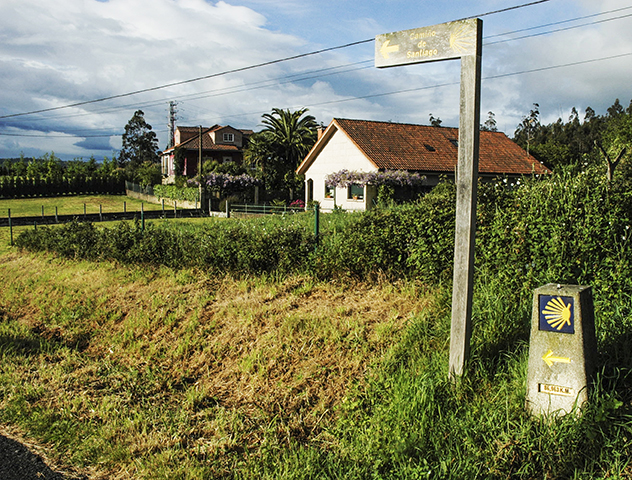
Above: Signposts mark the way for pilgrims along the St. James Way.
Chestnut trees used to cover the land here and were valued for their healing powers. At the Santa Cristina de Ribas de Sil Monastery, we saw centuries-old chestnut and oak trees.
Happily, another exotic import, camellias, became favourites in the gardens of manor houses (pazos) and there is now a series of pazos which boast huge woods of camellias. At the Pazo Oca, there are over 30,000 varieties.
The Pazo de Rubianes has 25 acres of Albariño vineyards. You can see exactly what the plant looks like, as the plants are no more than 6-feet-tall, allowing the grapes to be harvested by workers on foot, avoiding the use of machinery.
Albariño grapes are reused to make augardente: strong firewater meant to keep away meigas and bruxas, that is good and bad witches, a legacy of the Celtic times.
At Oseira monastery, one is likely to meet some of the hardiest pilgrims and walkers in Galicia. They have tackled the Silver Route (named in Moorish times), leaving Seville, a route that involves strenuous climbing throughout. Oseira is located at the foot of a beautiful road, and offers accommodation for the exhausted walker or pilgrim. We had a good chat with one of the 11 remaining Cistercian monks, Father Alfonso. He hails from Seville and has lived at the monastery for eight years. He said the part of the monastic that he enjoyed the most was the reflection and contemplation it afforded him.
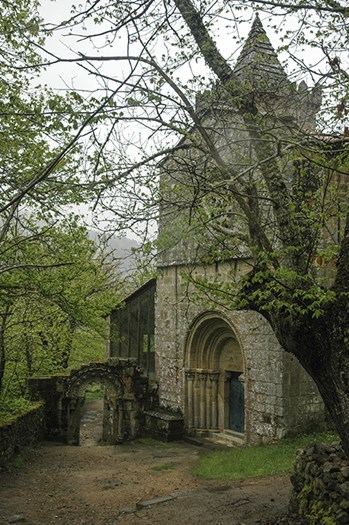
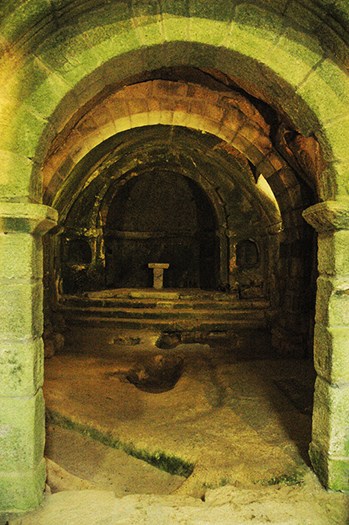
Left: The San Pedro de Rocas dates back to 575 AD. Right: San Pedro's alter.
We ended up buying a tiny 200ml bottle of Eucalyptus liquor, reputed to cure any throat disorder.
Our guide had advice, saying, “I hope you never need to use it, it tastes terrible!” After a week of tasting local Albariño and other Rias Baixas wines, we couldn’t imagine anything from this part of Spain having a bad taste.
The most ancient monastery in Spain (founded 575 AD) is found at San Pedro de Rocas. As someone said nicely, its value is more anthropological than aesthetic.
The entire church and living area were carved out of solid rock, including the tombs of the original monks. The sacred waters here have cured the ill for centuries.
Back at the San Estevo (now a luxury Parador hotel and once a living monastery), where the birds chirp constantly, there are reminders everywhere of the monastic past. We eat supper in the former stables, a truly magnificent hall with 15-metre-high ceilings, protected by eight-foot thick granite walls. In the monks’ reading room, there is one of the most attractively decorated Scandinavian style spas I’ve ever come across.
Legend says that a hermit living near Santiago noted one night that falling stars were all hitting the earth at the same spot. Intrigued by this, he eventually discovered that this spot contained the earthly remains of St. James (Santiago in Spanish), and the area eventually became the destination of pilgrims starting as early as the 10th century.
San Estevo, like the many monasteries that have been preserved, have different functions today. As I sit so comfortably in its present-day spa, I can’t help but wonder, “what would the monks think of this?”
About the Author
Marc Atchison is a veteran journalist and a seasoned traveller with more than 20 years of travel writing experience. As the former Travel Editor of the Toronto Star, Canada's largest newspaper, and now Editor-in-Chief and Senior Writer for TraveLife magazine (Canada) and travelife.ca, Marc has been to over 100 countries in the world. Japan is one of his favorite destinations and he's been there on numerous occasions.